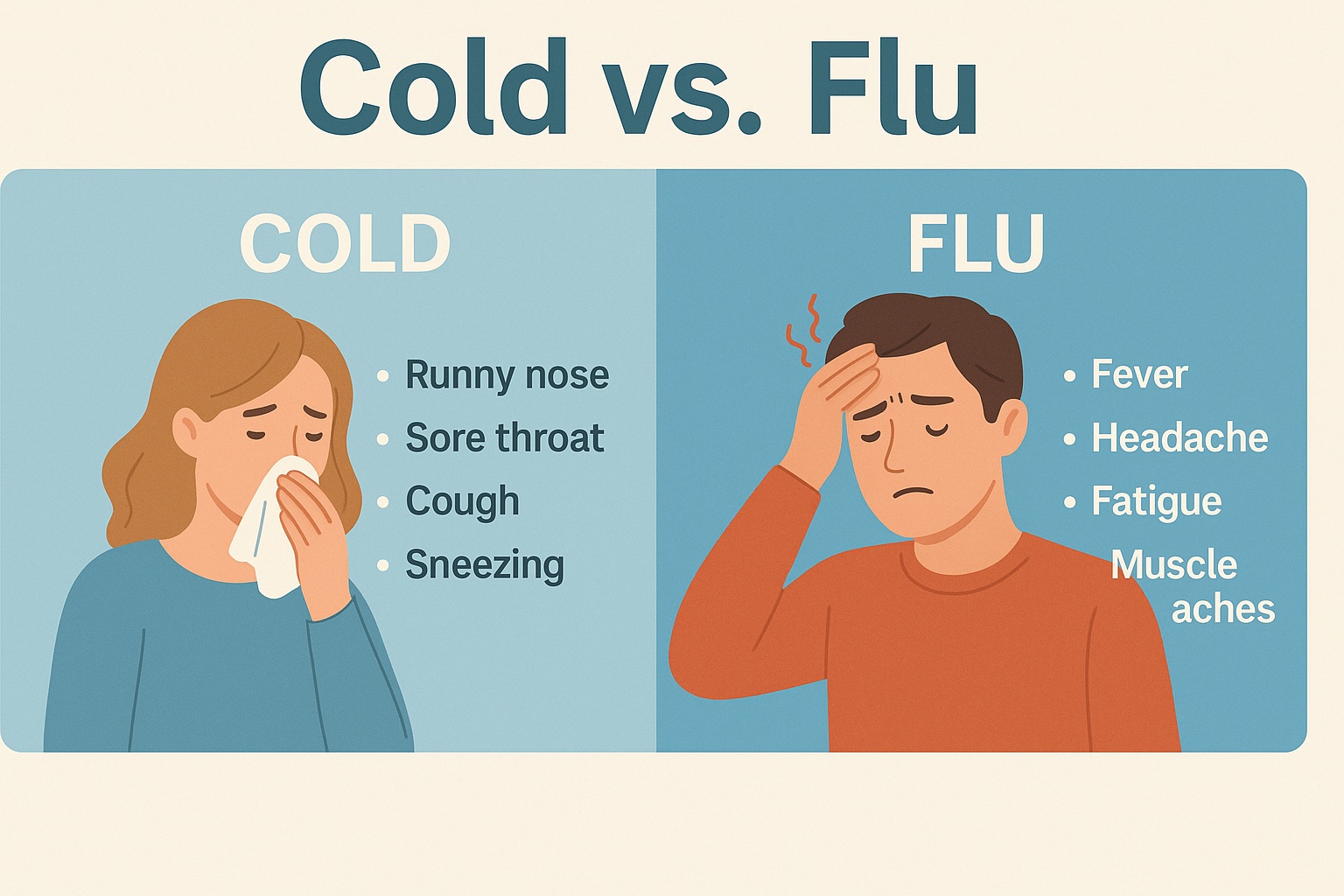Cold vs Flu Symptoms: Why It’s Important to Know the Difference
Cold vs flu symptoms can be confusing because both illnesses share similar signs—coughing, sore throat, congestion—but knowing which one you have makes a big difference. Flu can escalate into serious complications, while a common cold is usually mild. This article breaks down how to tell the difference quickly and accurately, helping you decide when to rest, when to see a doctor, and how to recover faster.
What Causes a Cold vs the Flu?
Both the common cold and the flu are caused by viruses, but different types. Colds usually come from rhinoviruses, while the flu is caused by influenza viruses. While both spread through droplets from coughs, sneezes, and surface contact, flu strains tend to be more aggressive and widespread during seasonal outbreaks.
Main Cold vs Flu Symptoms Compared
Here’s a side-by-side comparison of the most common symptoms to help you distinguish between a cold and the flu:
- Onset: Cold symptoms develop gradually, while flu symptoms appear suddenly.
- Fever: Rare with colds, common with the flu (often high, 100.4°F or more).
- Chills and body aches: Mild or absent in colds, often severe in flu cases.
- Fatigue: Mild with a cold, but flu often causes intense exhaustion.
- Sore throat: Common in both, but more persistent with a cold.
- Cough: Present in both, but flu coughs are typically dry and deeper.
- Runny or stuffy nose: More common in colds, occasional in flu.
- Headaches: Rare with colds, frequent with flu.
Chart: Cold vs Flu Symptoms at a Glance
Use this table as a quick reference to understand how the two conditions differ:
| Symptom | Cold | Flu |
|---|---|---|
| Fever | Rare | Common, high |
| Body aches | Minor | Often severe |
| Onset | Gradual | Sudden |
| Fatigue | Mild | Extreme |
| Runny nose | Common | Occasional |
| Headaches | Uncommon | Common |
How Long Do Cold and Flu Symptoms Last?
Cold vs flu symptoms also differ in duration. Colds usually resolve within 7 to 10 days, although a lingering cough or stuffy nose can last longer. Flu symptoms are often more intense and last about 1 to 2 weeks, with fatigue potentially stretching into a few more weeks for some people.
When to Seek Medical Help
Most cold and flu cases can be managed at home, but some signs require prompt medical attention:
- Fever above 103°F that lasts more than three days
- Severe chest pain or difficulty breathing
- Confusion, dizziness, or fainting
- Persistent vomiting or dehydration
- Symptoms that improve and then suddenly worsen
Tips to Treat Cold and Flu at Home
Whether it’s a cold or the flu, supportive care helps your body heal faster. Here’s how to manage symptoms effectively:
- Stay hydrated — Water, herbal tea, and broths keep you from dehydrating.
- Rest — Sleep and downtime are crucial to immune recovery.
- Use OTC meds — Pain relievers, decongestants, and fever reducers can offer relief.
- Warm salt gargles — Help soothe sore throats.
- Humidifiers — Add moisture to dry indoor air and ease congestion.
Flu Prevention Tips for 2025
Prevention is still your best defense. Protect yourself and others by following these updated flu prevention guidelines for 2025:
- Get the flu shot annually
- Wash hands frequently and avoid touching your face
- Disinfect commonly touched surfaces
- Stay home when sick to avoid spreading germs
- Wear a mask in crowded public spaces during flu season
FAQs About Cold vs Flu Symptoms
- Can you have both cold and flu at the same time?
Yes, it’s rare but possible to be infected with more than one virus. - Is the flu more dangerous than a cold?
Yes. Flu can lead to pneumonia, hospitalizations, and serious complications. - Do antibiotics help?
No. Colds and flu are viral; antibiotics only treat bacterial infections.
Conclusion: Know the Signs, Recover Smarter
Understanding the key cold vs flu symptoms helps you respond faster and smarter. Whether it’s a mild cold or a severe case of the flu, recognizing what you’re dealing with leads to better treatment, fewer complications, and faster recovery. Stay informed, take care, and be proactive this flu season.



